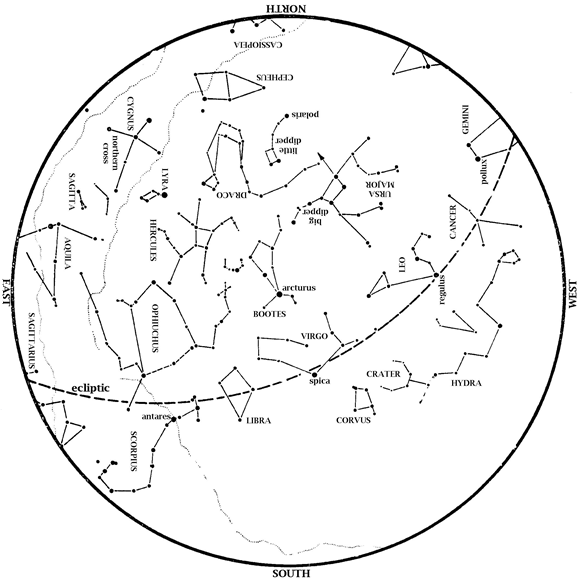They say, “home is where the heart is”, and in my case that is true. However, home is also where you say things like, “Don’t kill that Black Widow. I need it…,” or “So………do you have any plans for that dead armadillo?”
My parents live on a working ranch, complete with cows and buzzards, hay rakes and snakes. This affords me the opportunity, after chores are done and frankly sometimes during, to go science-ing.

Here’s everyone getting ready for vaccinations and the bovine version of OFF!
This last visit, when various assignments were being discussed and doled out, I jumped on the wood pile. The premise of this chore was that a gate was left open or a latch broke somewhere, allowing the cows through a fence and into the yard around the house. Cows, being kind of curious by nature, ended up everywhere. One of those wheres landed the cows between the workshop and the wood pile because the cows wanted to scratch on all those log ends sticking out. Unfortunately for my parents, a 1,400 pound cow determined to scratch an itch is no match for a metal pipe rack and stacked wood and so over it went. Fortunately for me, critters live in wood piles….
My mom’s instructions were clear: make the wood pill neat. My instructions to my nephew and my sister-in-law were also clear: don’t smash anything good. The first new friend we found was this guy.
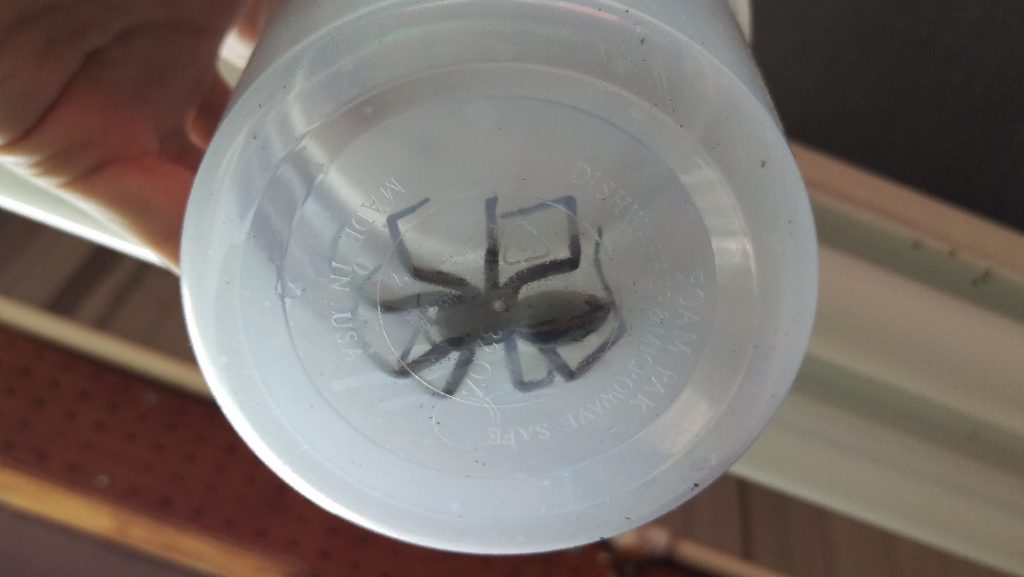
Who has eight legs and two pedipalps and is HUGE? This guy…
He is some species of wolf spider and he was GIGANTIC. This guy ended up getting some soapy water thrown on him because I wanted to pin him out (and he was also terrifyingly large), but everyone else we caught got to live.
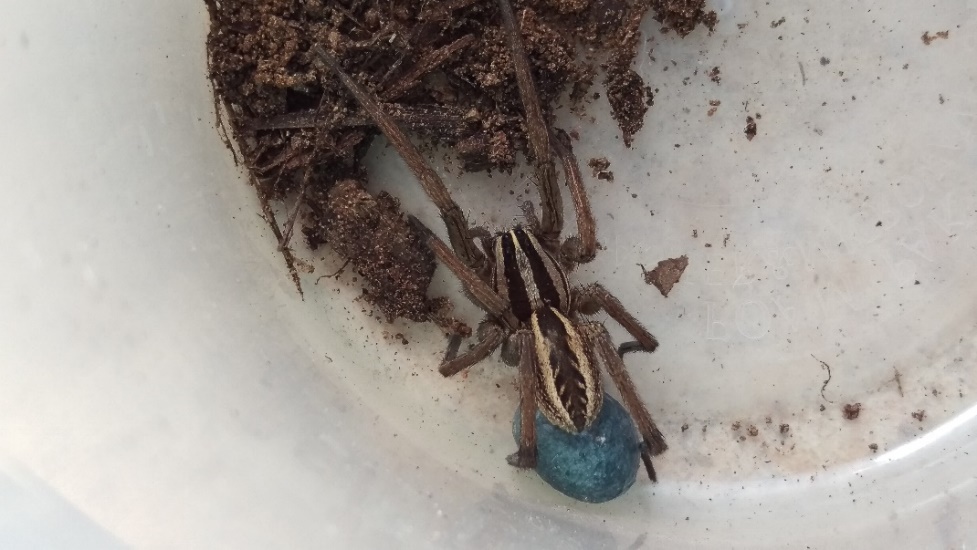 The next new friend we found was a cousin to that wolf spider. I collected her because she has this beautiful blue egg sack. When we got her back to the Museum and put her in her new apartment, she was hungry! Several snacks later, she settled down under some leaves for a nap. (Update: She is loving living at the Museum! She has rearranged the furniture and plumped up a bit in anticipation of the arrival of her brood. Wolf spiders are great moms, so we will take some pictures of her and the fam once they arrive!)
The next new friend we found was a cousin to that wolf spider. I collected her because she has this beautiful blue egg sack. When we got her back to the Museum and put her in her new apartment, she was hungry! Several snacks later, she settled down under some leaves for a nap. (Update: She is loving living at the Museum! She has rearranged the furniture and plumped up a bit in anticipation of the arrival of her brood. Wolf spiders are great moms, so we will take some pictures of her and the fam once they arrive!)
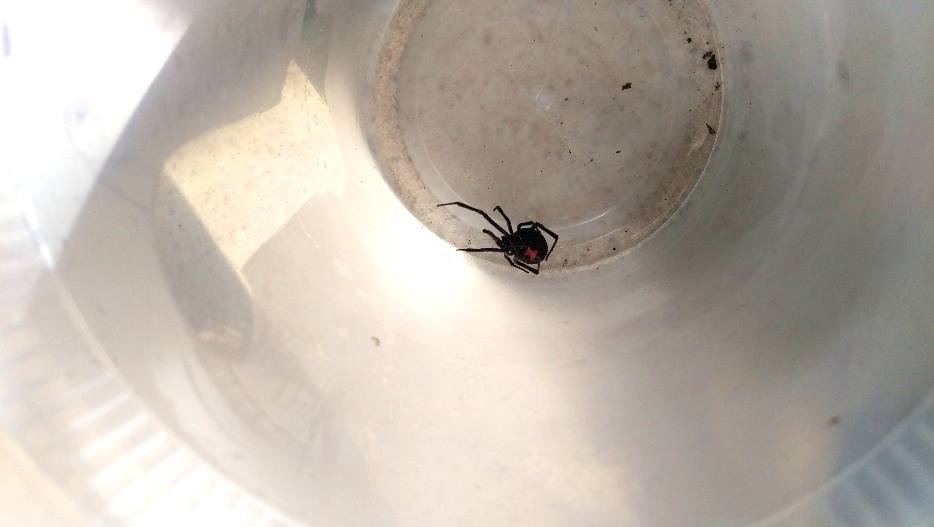 Now about the time I said, “Man, I’m super bummed we haven’t found any black widows,” this little lady showed up. I was super excited because we have been making some efforts to collect for an upcoming exhibit called Death by Natural Causes. She is a beautiful, fully grown Latrodectus mactans. How can you tell that she is fully grown? The juveniles have a red strip that runs down the back. When the spiders molt, the strip gets shorter and shorter until all you have is the tell-tale hour glass.
Now about the time I said, “Man, I’m super bummed we haven’t found any black widows,” this little lady showed up. I was super excited because we have been making some efforts to collect for an upcoming exhibit called Death by Natural Causes. She is a beautiful, fully grown Latrodectus mactans. How can you tell that she is fully grown? The juveniles have a red strip that runs down the back. When the spiders molt, the strip gets shorter and shorter until all you have is the tell-tale hour glass.
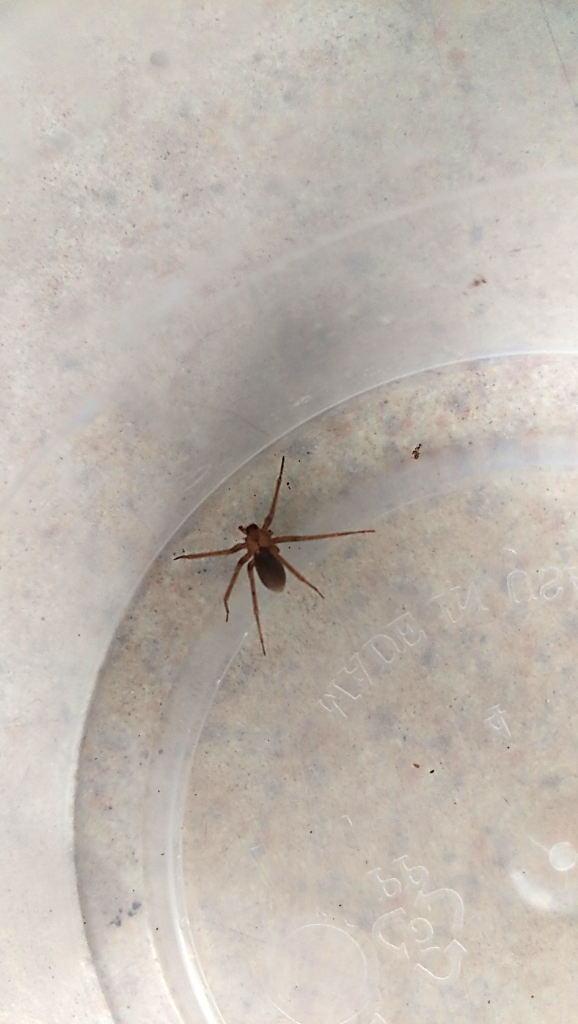 The next log I picked up, after scooping up the Black Widow, had this sweet little girl on it. What’s that you say? It’s a Brown Recluse? Why, yes it is. Both the Brown Recluse and the Black Widow have a bad reputation. Yes… both can potentially cause humans some problems, but they will also go above and beyond to avoid people if at all possible. Generally, the only time they bite is if they get pinned by a finger or arm or foot and are trying to defend themselves. You be nice to them; they’ll be nice to you.
The next log I picked up, after scooping up the Black Widow, had this sweet little girl on it. What’s that you say? It’s a Brown Recluse? Why, yes it is. Both the Brown Recluse and the Black Widow have a bad reputation. Yes… both can potentially cause humans some problems, but they will also go above and beyond to avoid people if at all possible. Generally, the only time they bite is if they get pinned by a finger or arm or foot and are trying to defend themselves. You be nice to them; they’ll be nice to you.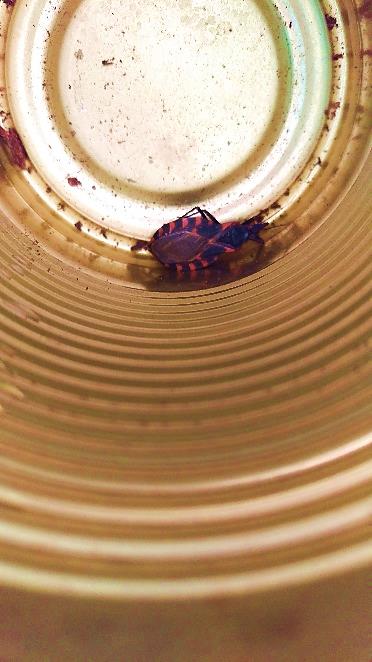 At this point, I ran out of collecting containers but the day had just begun! The next critter that crawled out from under a log was this little Triatoma sanguisuga. Commonly known as kissing bugs, this little guys is possibly a vector for Chagas. There have been a number of studies initiated of late to keep track of Chagas transmission, but there isn’t a lot known about where it is and what it is infecting because most states don’t require anyone to keep track of the confirmed human cases.
At this point, I ran out of collecting containers but the day had just begun! The next critter that crawled out from under a log was this little Triatoma sanguisuga. Commonly known as kissing bugs, this little guys is possibly a vector for Chagas. There have been a number of studies initiated of late to keep track of Chagas transmission, but there isn’t a lot known about where it is and what it is infecting because most states don’t require anyone to keep track of the confirmed human cases.
The fastest new friend we made, and the only one we didn’t collect because I didn’t have the right parts with me, was this little guy. He was at the bottom of the pile eating all the critters we were trying to collect. He zipped out and under the rack when we disturbed the log he was under. My parents have lived on their ranch for about 15 years. In that time I have only seen four snakes: One was the little ribbon snake below, the second was a smaller version of this ribbon snake we saw the same day under a pile of hay, the third was a juvenile water moccasin sunning in the tank and the fourth was a coach whip. Conclusion: Snakes are good at hide and seek.
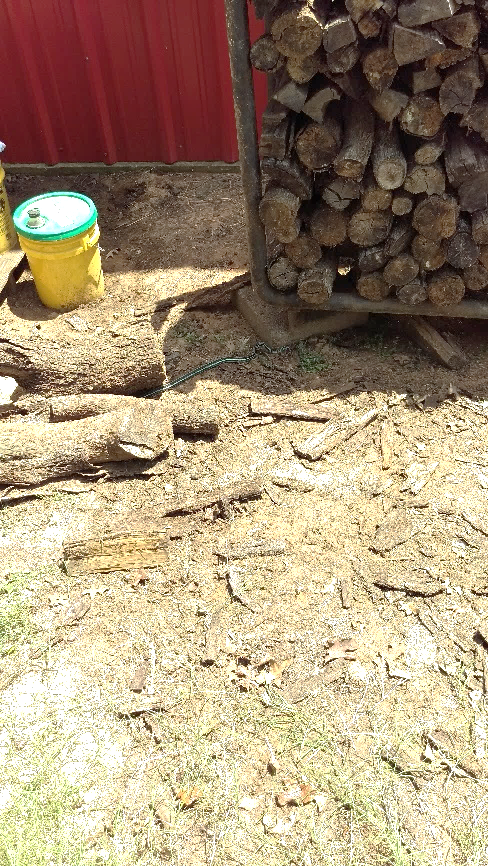 Later that day, after chores were done, we were sitting on the back porch with a Lone Star to cool off and this friend stopped by for a visit. Cicada nymph molts are generally what people know or see of Cicadas in Texas, although you are probably familiar with the noises they make as well. You will find the molts attached to tree bark or the brick of your house, split down the back. During their two to five-year life span, these cicadas spend just a couple months in the form you see in the picture. They are big but they are also 0% harmful to humans. They just want to chill out with you while you share a beer.
Later that day, after chores were done, we were sitting on the back porch with a Lone Star to cool off and this friend stopped by for a visit. Cicada nymph molts are generally what people know or see of Cicadas in Texas, although you are probably familiar with the noises they make as well. You will find the molts attached to tree bark or the brick of your house, split down the back. During their two to five-year life span, these cicadas spend just a couple months in the form you see in the picture. They are big but they are also 0% harmful to humans. They just want to chill out with you while you share a beer.
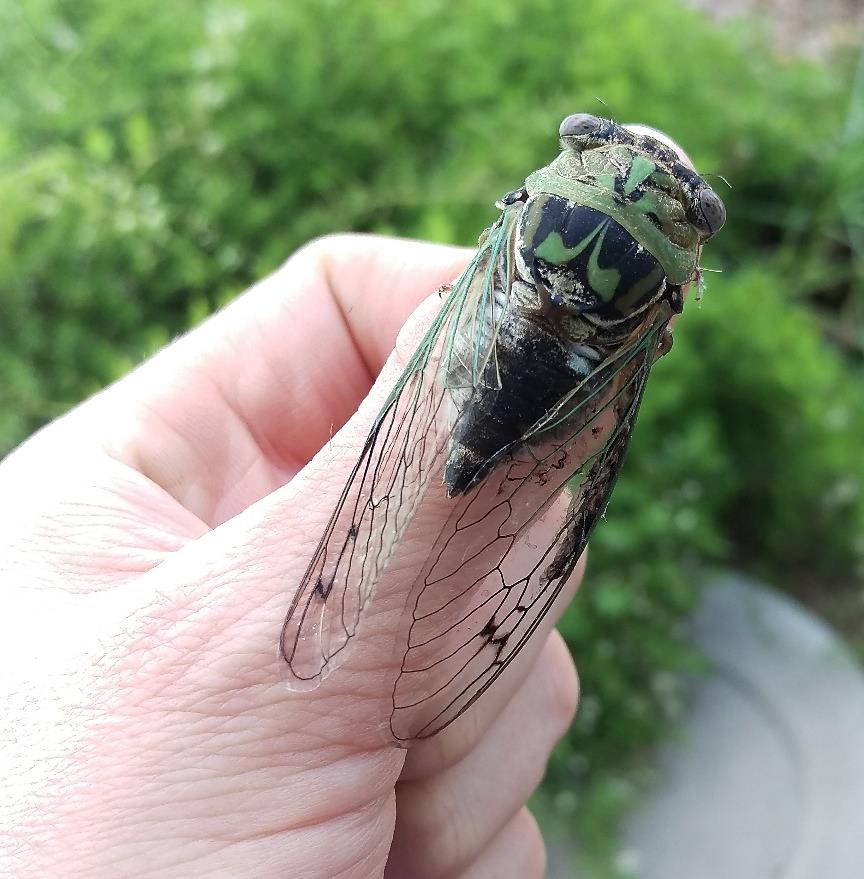
Also on the porch wanting to join the party? This female ox beetle. How can you tell it is female? The guys have these cool horns on their thorax that make them look like little beetle-y triceratops. Ox beetles live just a couple of months and are active during the summer. Their main job is recycling plant matter into compost, but that mostly happens in the larval form when they are just little, white, C-shaped grubs. They do fly in the adult form and, while it can be a little scary to unexpectedly find a big, brown, two-inch bug all up in your business, this guy is not harmful to humans at all. If you see one out, it is probably just cruising for a rotten log to lay some eggs.
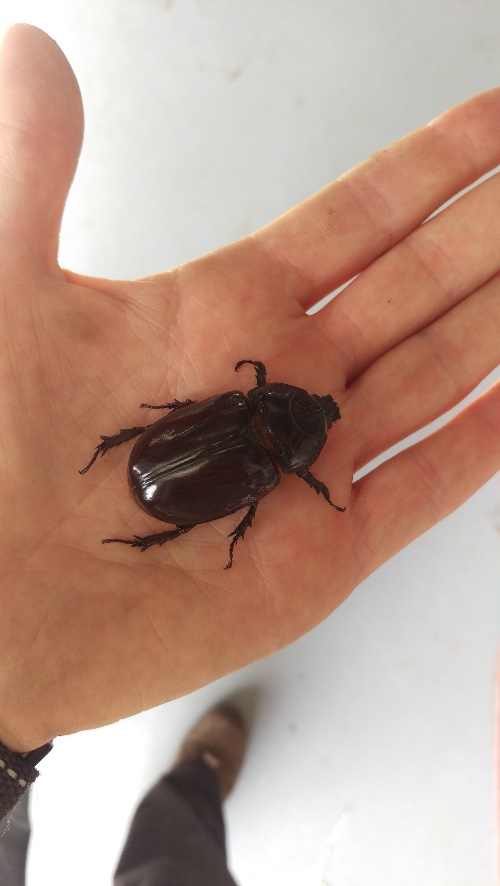
The last critter of the day was this armadillo who met with an untimely death the night before when he ended up with the pool. As part of the shady, after chore discussions I asked my dad what he planned on doing with that armadillo. Ya know… because he had dibs. He indicated that his actual plan involved putting it in the woods to be recycled by the decomposers. I asked if I could have it for our education collections.
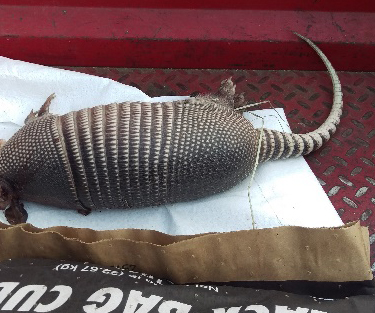
A little known fact, or at least something that most folks don’t think very hard about, is that all the specimens we use for teaching have to come from someplace and generally, you can’t get a pinned butterfly or a bobcat skull at Wal-mart. This being the case, we have to make or find all of our specimens for the teaching collection. Sometimes this is reeeaaalllly unpleasant.
It was the armadillo that causes my mom to question all of her life choices that led me to this point my life and wonder what she had done wrong. After dinner I hopped up to go skin the armadillo before it got dark. There was a lot of care taken on my part to keep clean because armadillos are known to carry leprosy. They are vectors for leprosy because armadillos and humans are about the same constant temperature and so the leprosy can snuggle right in and get comfy. People think that armadillos are giving leprosy to humans, but in reality humans probably gave it to them originally. You never see an armadillo exhibiting the signs of leprosy because they only live a short while. Two other fun facts about armadillos, the Aztecs called them āyōtōchtli, which translates to “turtle rabbit”; and, there are 21 extant species of armadillo that range from 5 to 59 inches long and 3 ounces to 120 pounds.
So, what do we do with all this stuff? It depends on the stuff. Most of these animals will get used in our live animal programs, labs, and summer camps. For those animals that are dead, or die after a long life of cricket pops and mealworm snacks, we try to preserve them for our educational collections. They may get used in the same programs, like the labs and the camps, but they also get put on display inside the classrooms, or for the special few, inside the Cabinet of Curiosities for you to come check out. So, if you do get the opportunity to check out some of our educational specimens, please be careful with them! It takes a couple of months to find, collect and/or make each one!





